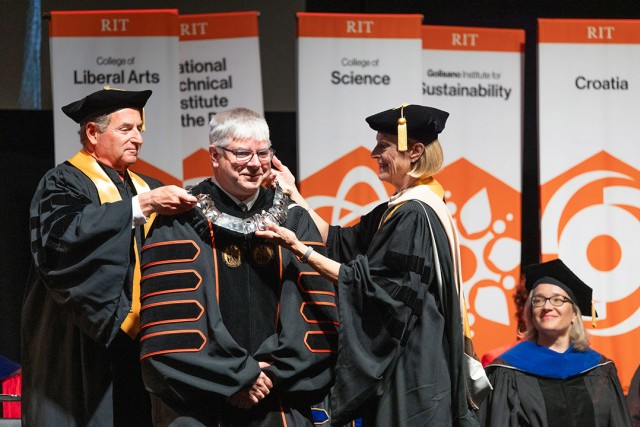GIS Industry 4.0 program receives $1.1M award to uplift New York State manufacturing in post-pandemic economy
The Golisano Institute for Sustainability (GIS) at Rochester Institute of Technology (RIT) was awarded $1.1 million by the U.S. Economic Development Administration (EDA) to accelerate RIT’s Industry 4.0 Transition Program within two Upstate New York regions, the Finger Lakes and Central New York. The funding was allocated through the Coronavirus Aid, Relief, and Economic Security Act (CARES Act) and aims to expand access to Industry 4.0 technologies across the targeted regions among small and medium-sized manufacturers (SMMs) still ailing from the economic impacts of COVID-19.
The project was announced by Congressman Joseph Morelle, Senate Majority Leader Chuck Schumer, and Senator Kristen Gillibrand on September 7, 2021. Projects awarded for CARES Act funding are selected for their potential to sustain post-COVID-19 recovery while building long-term economic resiliency.
Manufacturers in New York State’s Finger Lakes and Central regions have faced unprecedented challenges in the aftermath of the coronavirus pandemic, from negotiating ongoing supply chain disruptions to ensuring a safe working environment. For many companies in New York State, these barriers come as competition is already on the rise from SMMs nationally and globally that are incorporating automation and data-driven decision-making into how they work.
RIT’s Industry 4.0 Transition Program is designed to help SMMs across New York State understand and take advantage of the newest technologies shaping manufacturing today. The comprehensive program not only builds awareness, but guides companies in the creation of scalable, actionable implementation plans. In addition to strategic guidance, participants also receive technical assistance through RIT.
The CARES Act provided the EDA with $1.5 billion for economic development programs to help communities prevent, prepare for, and respond to COVID-19. EDA CARES Act Recovery Assistance, which is administered under the agency’s Economic Adjustment Assistance (EAA) program, provides a wide-range of funding to local and regional efforts responding to the pandemic.
GIS will work with local Manufacturing Extension Partnership (MEP) centers, manufacturing trade organizations, regional planning organizations, and other partners to ensure that manufacturers in the two target regions have the opportunity to participate. In the Finger Lakes, GIS will collaborate with the Genesee/Finger Lakes Regional Planning Council (G/FLRPC), which was recently awarded an EDA CARES Act grant that entails a broader planning and assistance coordination effort in the region. Additional partners in the Finger Lakes include NextCorps and the Rochester Technology and Manufacturing Association (RTMA), which will assist with outreach to encourage SMM participation. In Central New York, RIT will partner with Train, Develop, Optimize (TDO), formerly the Central New York Technology Development Organization, to support outreach activities.
“A strong, globally competitive manufacturing sector will ensure communities in the Finger Lakes and Central regions of New York State are economically viable. This project will facilitate adoption of Industry 4.0 technologies by manufacturers, assisting them to identify appropriate solutions to meet their immediate needs and to prepare for the future,” said Nabil Nasr, director and associate provost of GIS. “Adaptability, agility, connectivity, and supply chain resilience is the new hallmark of a sustainable, competitive company. This program gives manufacturers the right knowledge and advanced tools to be more competitive, thus increasing business and, in turn, expanding their workforce needs.”
RIT’s Industry 4.0 Transition Program is led by Ajay Khaladkar, technical program manager of advanced manufacturing and Industry 4.0 solutions at GIS.
This material is based upon work supported by the Department of Commerce Economic Development Administration under Award No 01-79-15124. The article was prepared by RIT using federal funds under award No. 01-79-15124 from the Department of Commerce Economic Development Administration. The statements, findings, and conclusions or recommendations expressed in this material are those of the author(s) and do not necessarily reflect the views of the Department of Commerce or the Economic Development Administration.
Funding is also provided by the New York State Department of Economic Development (DED). Any opinions, findings conclusions or recommendations expressed are those of the author(s) and do not necessarily reflect the views of the DED.





